|

Special Issue, August 27, 2002
A One-Day Trip at 7000 ft.
by Herman Brown
herman@fungi-zette.com
Back to SPECIAL ISSUES
|
As we walked
around the area we started finding more, some rather large, some very
young. We took home almost everything we found, as we use the
oregonense for it's claimed medicinal properties.
We even took
some of the young ones with us to cook for eating.
Later, when we got home, I cooked
up several of the younger ones, trying different degrees of
agedness, cooking slowly with a little salt and a lot of olive
oil.
It seemed that the younger they
were, the sweeter they were, and as they got older, they started
to get bitter, but even those were tender.
|
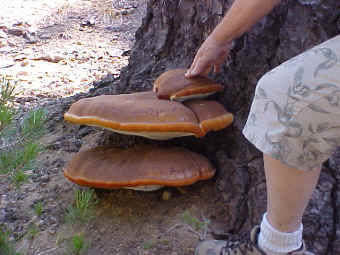
A big bunch
|
| We didn't see any fresh Sulfur
Shelf at the first seepage area.
|
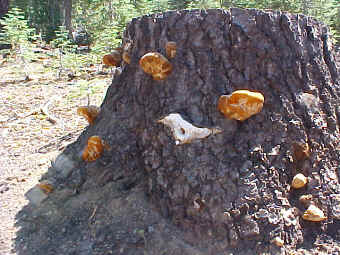
Some young ones
|
|
As we drove farther south we saw more in the
tree stumps above the road, the same trees we had found some
years ago.
Then we went to the next seepage about a
half mile farther up the road to see if we could find the meadow we had
seen at a previous MSSF foray. The meadow was still pretty wet, so
we walked in the trees that skirted the meadow.
Cecelia immediately found what
looked like a bunch of Rozites caperatus. Some were still
buried, but I picked all 4 of them.
On the way back to the truck we found more
boletes, similar to the first one I found, but in a small bunch and with a
red tinge on the stems.
|
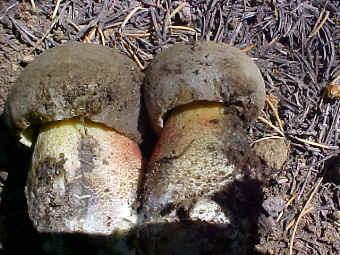
Bitter Boletes
|
|
Close to that I found a tight bunch of gray Lactarius with scant
water-white latex and mild taste. |
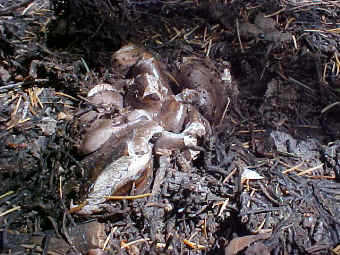
Bunch of Lactarius sp.
|
|
Before we got to the truck we finally found
some of Sulfur Shelf, (Laetiporus conifericola) but it didn't look too appetizing, There were
many other places we walked by that looked like there were batches of last year's
Sulphur Shelf.
We finally turned the truck towards home
and drove very slowly looking for more Ganoderma. We found a
few more, and enjoyed the pleasant aroma given off by the Ganoderma as we
went along.
Close to the pass, we drove through the
campground there and found some very young Ganoderma and a few dried-up
Russulas. On the dirt road on the other side of the main road,
we stopped at another spot we had been with the MSSF, and found one huge
bolete that was about 18" in diameter.
|
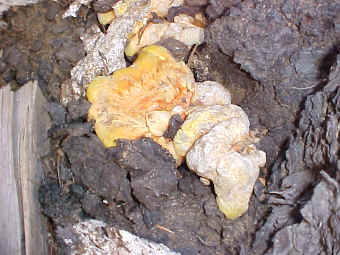
Sulfur Shelf
|
|
The cap was mostly gone after being eaten
off by a deer (probably), but the flesh blued and the pore surface was
beginning to turn reddish. It was too big to pick anyway, It didn't
look like an edible species for humans, so I left it for the
deer.
When I got home, I looked more
carefully at the boletes, noticed what looked like reticulations
on the one of the stalks and tasted both batches.
The taste was disappointedly bitter for all of them. I keyed
out the one with the reticulated stem to be the B. calopus.
|
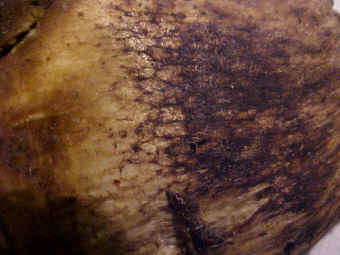
Stalk Reticulations?
|
| The other group didn't
seem to have the reticulations, and because of the red tinge on part of the stem, I keyed that
group out to probably be the B. rubripes. The Lactarius I couldn't key.
The "Rozites" kind of looks like one of Mike Wood's pictures, and I will be
more sure when I get a spore print and look at it under the
microscope.
Follow up: The next
day I looked at a section of the "Rozites" under my microscope.
The spores looked like the description for the Rozites caperatus
that was in David Arora's book, Mushrooms Demystified.
After comparing one of my pictures
to one of Mike Wood's pictures, I decided it was the Rozites and
cooked them for dinner.
|
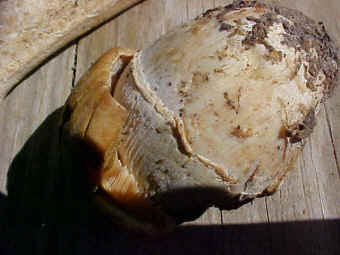
Close-up of the
"Rozites", showing a slight veil
|
|